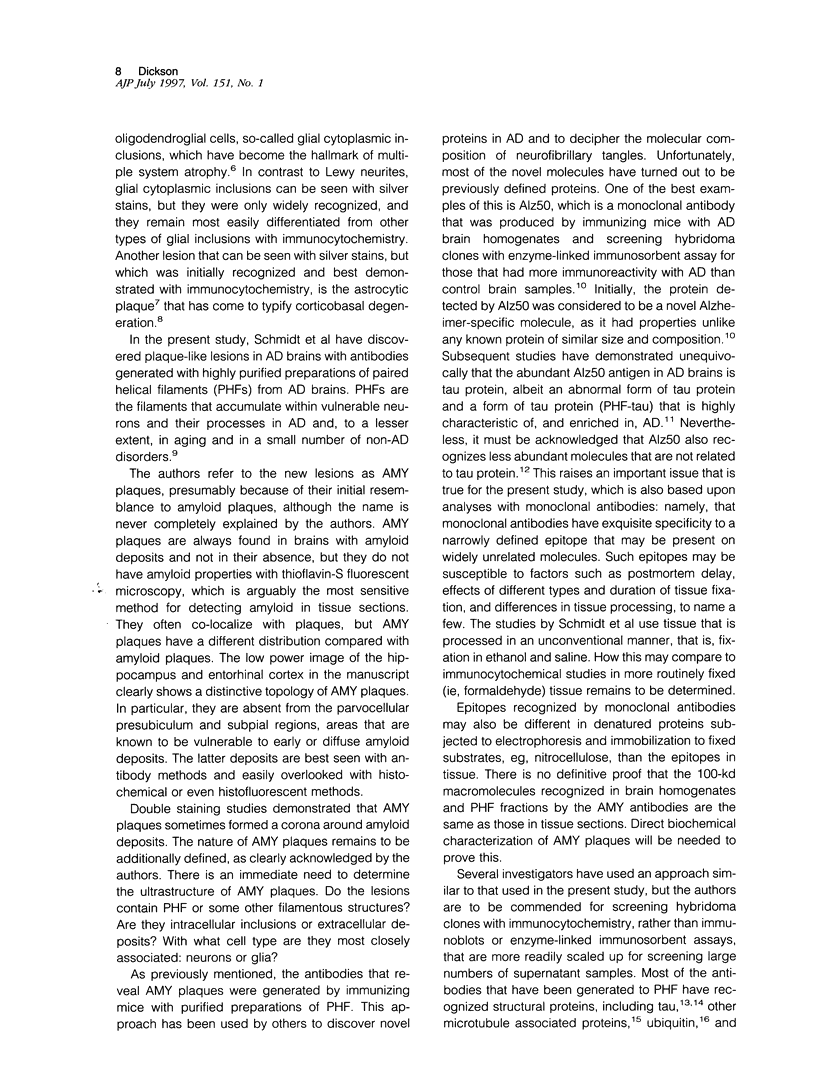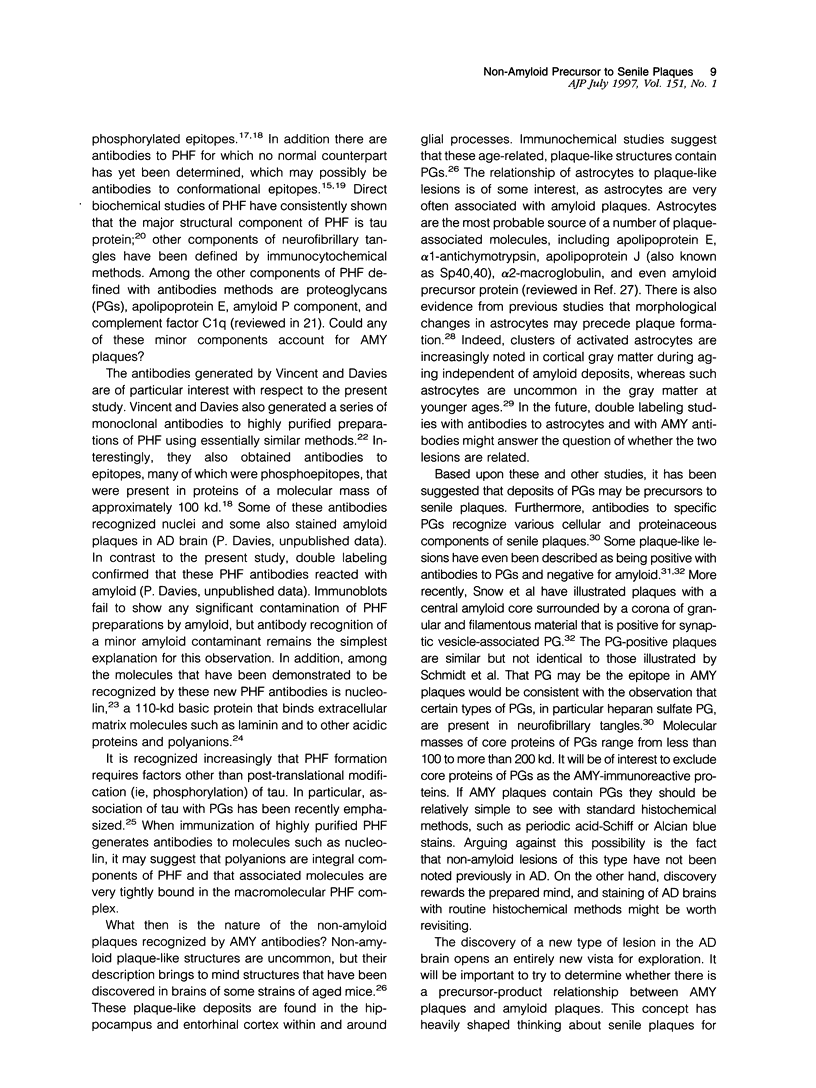Abstract
The manuscript by Schmidt et al reports that antibodies generated to paired helical filaments (AMY antibodies) unexpectedly labeled novel non-amyloid, plaque-like structures (AMY plaques) in aged and Alzheimer's disease brains. The full disclosure of the nature of these lesions awaits additional structural and biochemical studies, but at first glance there are interesting parallels between AMY plaques and recently described lesions composed of glia and glia-associated proteoglycans in brains of aged mice. The increasing recognition of the role of proteoglycans in paired helical filaments formation makes proteoglycans or their associated molecules attractive candidates for AMY-immunoreactive proteins. The relationship of AMY plaques to age-related glial changes that some have speculated may be precursors to senile plaques remains to be determined, as is the relationship of AMY plaques to more widely recognized amyloid-containing plaques. Future studies will determine whether AMY plaques are non-amyloid precursors to senile plaques or if they represent an independent type of structural lesion in the Alzheimer's disease brain. Ultimately, the clinical significance of AMY plaques will depend upon their characterization in brains of prospectively studied subjects.
Full text
PDF




Selected References
These references are in PubMed. This may not be the complete list of references from this article.
- Bowser R., Giambrone A., Davies P. FAC1, a novel gene identified with the monoclonal antibody Alz50, is developmentally regulated in human brain. Dev Neurosci. 1995;17(1):20–37. doi: 10.1159/000111270. [DOI] [PubMed] [Google Scholar]
- Buée-Scherrer V., Condamines O., Mourton-Gilles C., Jakes R., Goedert M., Pau B., Delacourte A. AD2, a phosphorylation-dependent monoclonal antibody directed against tau proteins found in Alzheimer's disease. Brain Res Mol Brain Res. 1996 Jul;39(1-2):79–88. doi: 10.1016/0169-328x(96)00003-4. [DOI] [PubMed] [Google Scholar]
- Chin S. S., Goldman J. E. Glial inclusions in CNS degenerative diseases. J Neuropathol Exp Neurol. 1996 May;55(5):499–508. doi: 10.1097/00005072-199605000-00001. [DOI] [PubMed] [Google Scholar]
- Dickson D. W., Mattiace L. A. Astrocytes and microglia in human brain share an epitope recognized by a B-lymphocyte-specific monoclonal antibody (LN-1). Am J Pathol. 1989 Jul;135(1):135–147. [PMC free article] [PubMed] [Google Scholar]
- Dickson D. W., Ruan D., Crystal H., Mark M. H., Davies P., Kress Y., Yen S. H. Hippocampal degeneration differentiates diffuse Lewy body disease (DLBD) from Alzheimer's disease: light and electron microscopic immunocytochemistry of CA2-3 neurites specific to DLBD. Neurology. 1991 Sep;41(9):1402–1409. doi: 10.1212/wnl.41.9.1402. [DOI] [PubMed] [Google Scholar]
- Dickson D. W. The pathogenesis of senile plaques. J Neuropathol Exp Neurol. 1997 Apr;56(4):321–339. doi: 10.1097/00005072-199704000-00001. [DOI] [PubMed] [Google Scholar]
- Feany M. B., Dickson D. W. Neurodegenerative disorders with extensive tau pathology: a comparative study and review. Ann Neurol. 1996 Aug;40(2):139–148. doi: 10.1002/ana.410400204. [DOI] [PubMed] [Google Scholar]
- Feany M. B., Dickson D. W. Widespread cytoskeletal pathology characterizes corticobasal degeneration. Am J Pathol. 1995 Jun;146(6):1388–1396. [PMC free article] [PubMed] [Google Scholar]
- German D. C., White C. L., 3rd, Sparkman D. R. Alzheimer's disease: neurofibrillary tangles in nuclei that project to the cerebral cortex. Neuroscience. 1987 May;21(2):305–312. doi: 10.1016/0306-4522(87)90123-0. [DOI] [PubMed] [Google Scholar]
- Goedert M., Jakes R., Spillantini M. G., Hasegawa M., Smith M. J., Crowther R. A. Assembly of microtubule-associated protein tau into Alzheimer-like filaments induced by sulphated glycosaminoglycans. Nature. 1996 Oct 10;383(6600):550–553. doi: 10.1038/383550a0. [DOI] [PubMed] [Google Scholar]
- Goedert M., Wischik C. M., Crowther R. A., Walker J. E., Klug A. Cloning and sequencing of the cDNA encoding a core protein of the paired helical filament of Alzheimer disease: identification as the microtubule-associated protein tau. Proc Natl Acad Sci U S A. 1988 Jun;85(11):4051–4055. doi: 10.1073/pnas.85.11.4051. [DOI] [PMC free article] [PubMed] [Google Scholar]
- Greenberg S. G., Davies P. A preparation of Alzheimer paired helical filaments that displays distinct tau proteins by polyacrylamide gel electrophoresis. Proc Natl Acad Sci U S A. 1990 Aug;87(15):5827–5831. doi: 10.1073/pnas.87.15.5827. [DOI] [PMC free article] [PubMed] [Google Scholar]
- Jucker M., Walker L. C., Schwarb P., Hengemihle J., Kuo H., Snow A. D., Bamert F., Ingram D. K. Age-related deposition of glia-associated fibrillar material in brains of C57BL/6 mice. Neuroscience. 1994 Jun;60(4):875–889. doi: 10.1016/0306-4522(94)90269-0. [DOI] [PubMed] [Google Scholar]
- Kibbey M. C., Johnson B., Petryshyn R., Jucker M., Kleinman H. K. A 110-kD nuclear shuttling protein, nucleolin, binds to the neurite-promoting IKVAV site of laminin-1. J Neurosci Res. 1995 Oct 15;42(3):314–322. doi: 10.1002/jnr.490420305. [DOI] [PubMed] [Google Scholar]
- Knopman D. S., Mastri A. R., Frey W. H., 2nd, Sung J. H., Rustan T. Dementia lacking distinctive histologic features: a common non-Alzheimer degenerative dementia. Neurology. 1990 Feb;40(2):251–256. doi: 10.1212/wnl.40.2.251. [DOI] [PubMed] [Google Scholar]
- Kosik K. S., Joachim C. L., Selkoe D. J. Microtubule-associated protein tau (tau) is a major antigenic component of paired helical filaments in Alzheimer disease. Proc Natl Acad Sci U S A. 1986 Jun;83(11):4044–4048. doi: 10.1073/pnas.83.11.4044. [DOI] [PMC free article] [PubMed] [Google Scholar]
- Mori H., Kondo J., Ihara Y. Ubiquitin is a component of paired helical filaments in Alzheimer's disease. Science. 1987 Mar 27;235(4796):1641–1644. doi: 10.1126/science.3029875. [DOI] [PubMed] [Google Scholar]
- Novak M., Kabat J., Wischik C. M. Molecular characterization of the minimal protease resistant tau unit of the Alzheimer's disease paired helical filament. EMBO J. 1993 Jan;12(1):365–370. doi: 10.1002/j.1460-2075.1993.tb05665.x. [DOI] [PMC free article] [PubMed] [Google Scholar]
- Nukina N., Kosik K. S., Selkoe D. J. The monoclonal antibody, Alz 50, recognizes tau proteins in Alzheimer's disease brain. Neurosci Lett. 1988 May 3;87(3):240–246. doi: 10.1016/0304-3940(88)90455-7. [DOI] [PubMed] [Google Scholar]
- Papp M. I., Kahn J. E., Lantos P. L. Glial cytoplasmic inclusions in the CNS of patients with multiple system atrophy (striatonigral degeneration, olivopontocerebellar atrophy and Shy-Drager syndrome). J Neurol Sci. 1989 Dec;94(1-3):79–100. doi: 10.1016/0022-510x(89)90219-0. [DOI] [PubMed] [Google Scholar]
- Pike C. J., Cummings B. J., Cotman C. W. Early association of reactive astrocytes with senile plaques in Alzheimer's disease. Exp Neurol. 1995 Apr;132(2):172–179. doi: 10.1016/0014-4886(95)90022-5. [DOI] [PubMed] [Google Scholar]
- Schmidt M. L., Lee V. M., Forman M., Chiu T. S., Trojanowski J. Q. Monoclonal antibodies to a 100-kd protein reveal abundant A beta-negative plaques throughout gray matter of Alzheimer's disease brains. Am J Pathol. 1997 Jul;151(1):69–80. [PMC free article] [PubMed] [Google Scholar]
- Snow A. D., Mar H., Nochlin D., Sekiguchi R. T., Kimata K., Koike Y., Wight T. N. Early accumulation of heparan sulfate in neurons and in the beta-amyloid protein-containing lesions of Alzheimer's disease and Down's syndrome. Am J Pathol. 1990 Nov;137(5):1253–1270. [PMC free article] [PubMed] [Google Scholar]
- Snow A. D., Nochlin D., Sekiguichi R., Carlson S. S. Identification in immunolocalization of a new class of proteoglycan (keratan sulfate) to the neuritic plaques of Alzheimer's disease. Exp Neurol. 1996 Apr;138(2):305–317. doi: 10.1006/exnr.1996.0069. [DOI] [PubMed] [Google Scholar]
- Su J. H., Cummings B. J., Cotman C. W. Localization of heparan sulfate glycosaminoglycan and proteoglycan core protein in aged brain and Alzheimer's disease. Neuroscience. 1992 Dec;51(4):801–813. doi: 10.1016/0306-4522(92)90521-3. [DOI] [PubMed] [Google Scholar]
- TERRY R. D. THE FINE STRUCTURE OF NEUROFIBRILLARY TANGLES IN ALZHEIMER'S DISEASE. J Neuropathol Exp Neurol. 1963 Oct;22:629–642. doi: 10.1097/00005072-196310000-00005. [DOI] [PubMed] [Google Scholar]
- Vincent I., Rosado M., Davies P. Mitotic mechanisms in Alzheimer's disease? J Cell Biol. 1996 Feb;132(3):413–425. doi: 10.1083/jcb.132.3.413. [DOI] [PMC free article] [PubMed] [Google Scholar]
- Wolozin B. L., Pruchnicki A., Dickson D. W., Davies P. A neuronal antigen in the brains of Alzheimer patients. Science. 1986 May 2;232(4750):648–650. doi: 10.1126/science.3083509. [DOI] [PubMed] [Google Scholar]
- Yen S. H., Liu W. K., Hall F. L., Yan S. D., Stern D., Dickson D. W. Alzheimer neurofibrillary lesions: molecular nature and potential roles of different components. Neurobiol Aging. 1995 May-Jun;16(3):381–387. doi: 10.1016/0197-4580(95)00022-7. [DOI] [PubMed] [Google Scholar]


